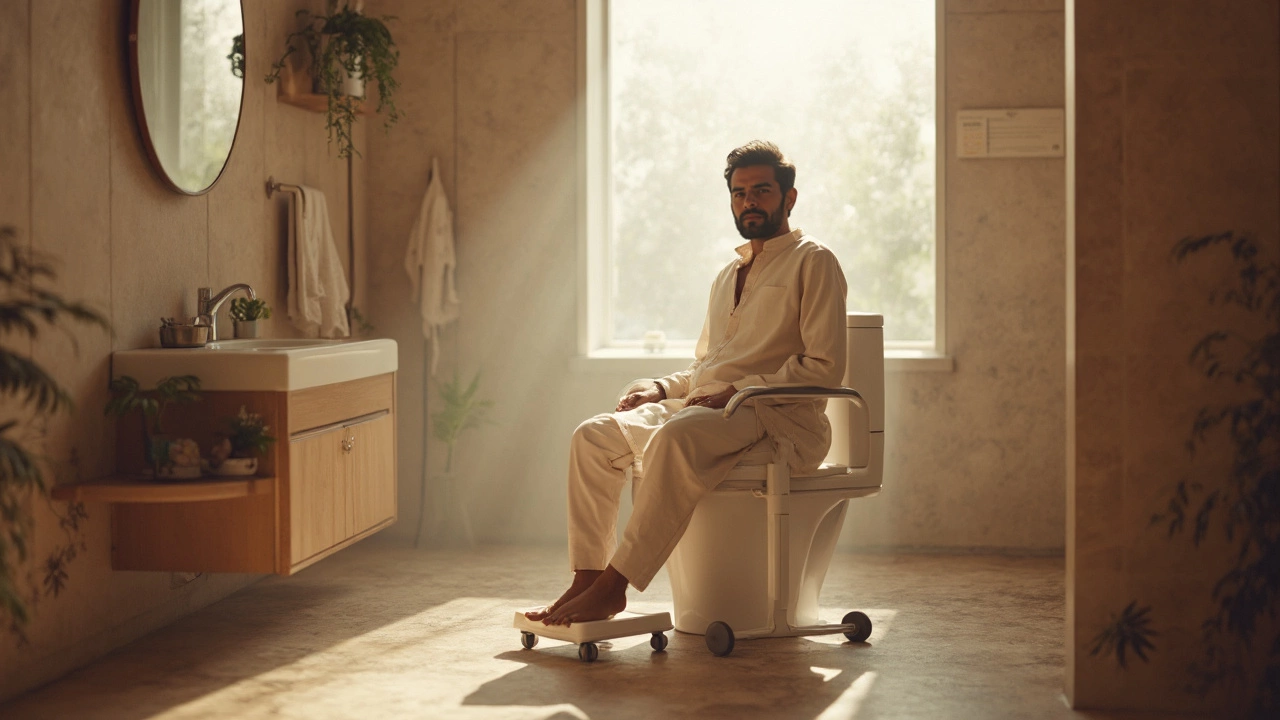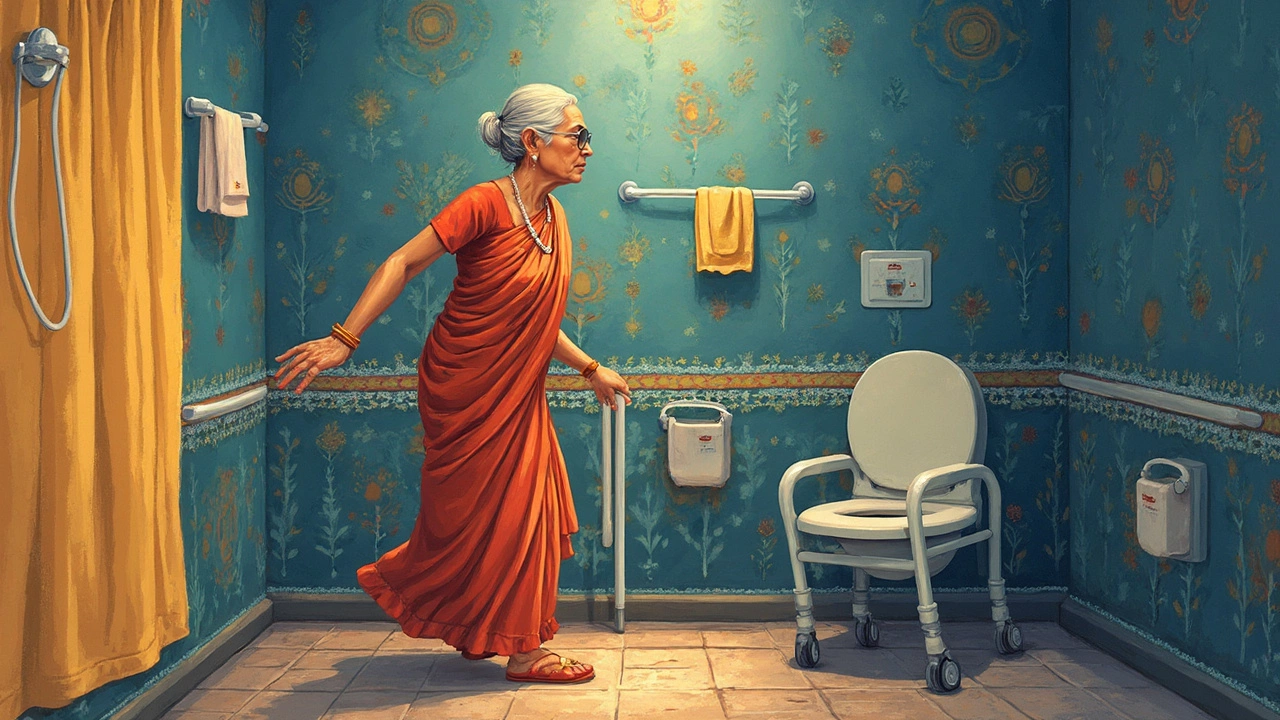
Finding comfort in everyday activities can be tricky after knee surgery, and using the toilet is no exception. Imagine having to balance on one leg or bending more than you should—sounds tough, right? Let's start with a simple-yet-essential idea: always ensure you have the right support.
An elevated toilet seat can be your best friend during recovery. It minimizes bending, easing pressure on your new knee. Grab bars are also a fantastic addition, helping you maintain balance as you sit and stand.
Of course, hygiene is key to recovery. Consider using wet wipes instead of toilet paper if reaching is challenging. Remember, it's okay to ask for assistance when needed—even small tasks can be daunting when you're healing.
- Importance of Proper Support
- Using Assistive Devices
- Maintaining Balance
- Posture Tips
- Hygiene Advice
- When to Seek Help
Importance of Proper Support
When you’ve just had knee replacement surgery, getting on and off the toilet can feel like a real challenge. Having the right support is not just about comfort—it's crucial for your safety and recovery. Let's talk about why it's so important.
First up, preventing falls is key. After surgery, your knee might not be as stable as before. The last thing you want is a slip in the bathroom. Installing grab bars next to the toilet gives you something to hold on to, making those transitions a lot safer.
Elevated Toilet Seats
An option many people don't consider is an elevated toilet seat. It simply raises the height of your toilet, meaning you don't have to bend your knee as much. This small change can significantly lessen the strain on your newly repaired joint. If you’re wondering where to find them, they're widely available at medical supply stores and even online.
Using the Right Tools
Let's be real—a standard bathroom setup isn't always post-surgery friendly. Adding a sturdy shower chair or commode could make a world of difference. They're not just for showers; you can use them anywhere near your toilet as extra seating and support.
And here's a tip: skid-resistant bath mats. They might sound basic, but these mats prevent slipping on one of the most slippery surfaces around—tiles. You've got to think of every little detail when it comes to recovery.
Another critical point: make sure to install these supports before your surgery if you can. It’s one less thing to worry about when you're fresh out of the hospital and already dealing with so much. Remember, the more care you take now, the easier your recovery will be.
Using Assistive Devices
After knee surgery, having the right aids at your disposal can make a world of difference. Ever tried to lower yourself onto a regular toilet post-surgery? A bit of a mission, isn't it? Let's simplify it with some handy devices.
Elevated Toilet Seats
These are a lifesaver when it comes to comfort and safety. An elevated seat reduces the amount of bending required for sitting down and standing up, keeping pressure off your new knee. Look for one with arms to ensure extra support.
Grab Bars
Installed near the toilet, grab bars provide stability and peace of mind. They can support your weight as you navigate sitting or standing. Always check they are securely mounted to avoid any mishaps.
Shower Chairs and Transfer Benches
If your bathroom journey includes a shower, a shower chair or transfer bench can be your best friends. They allow you to sit or slide across easily without compromising your balance.
Walker or Cane
Bring these into the bathroom if needed for additional support. Just be sure there’s enough space to maneuver safely around the toilet area.
| Device | Purpose |
|---|---|
| Elevated Toilet Seat | Minimizes bending |
| Grab Bars | Provides stability |
| Shower Chair | Supports safe showering |
| Walker/Cane | Aids balance |
Not sure which devices are right for you? Sometimes, a quick chat with your physical therapist can offer personalized solutions. So gear up, and make those necessary trips to the bathroom less of a chore!
Maintaining Balance
After a knee replacement, keeping your balance while using the toilet can feel like a juggling act. A crucial tip here is to rely on aids designed for stability. Think of them as the unsung heroes of your recovery journey.
Grab bars are a top priority in your bathroom setup. Place them strategically around the toilet so you can use them to ease down onto the seat and stand back up. They're not just about safety but also boosting your confidence, especially when you're still getting used to moving around post-surgery.
Foot Positioning
Another helpful tip is to be mindful of how you position your feet. Keeping both feet flat on the ground when sitting or standing offers better stability. Imagine you're building a solid foundation—your feet are the base!
Using Your Core
Engaging your core muscles can also support your balance. Think of it as your body's natural stabilizer. Tightening your stomach muscles as you sit or stand gives you extra support, which can make things feel a bit less wobbly.
Checklist for Safety
- Ensure the floor around the toilet is non-slip.
- Install a nightlight in the bathroom to avoid trips in the dark.
- Practice slow, controlled movements to reduce strain.
Keep in mind, it’s perfectly normal to feel off-balance at times. Remembering these small adjustments can make your post-surgery toilet visits less daunting and much safer.

Posture Tips
Getting your posture right can make the world of difference when you're fresh out of knee surgery. The way you sit can either support your recovery or put unnecessary pressure on your healing knee. Let's talk about how to make things more comfortable and safe.
1. Sit Up Straight
First things first, aim to sit up straight when you're on the toilet. Slouching can put stress on your lower back and, indirectly, on your knee. Use a raised toilet seat to make sitting and getting up easier.
2. Foot Position
Your feet should be flat on the ground. This position provides stability, reducing the risk of accidentally straining your leg. If your feet don't reach the floor, consider placing a small stool under them for a firm base.
3. Weight Distribution
Try to distribute your weight evenly on both hips. Leaning to one side might seem harmless, but it increases the risk of losing balance, not to mention possible discomfort for your healing knee.
Statistics on Post-Surgery Toilet Use
Here's a quick look at how many people find a change in bathroom posture helpful. A survey found that 70% of post-knee surgery patients who used a raised toilet seat felt a significant improvement in comfort and safety.
| Post-Surgery Aid | Patient Satisfaction |
|---|---|
| Raised Toilet Seat | 70% |
| Grab Bars | 65% |
| Small Foot Stool | 50% |
4. Focus on Core Muscles
Your core muscles are your best friends in this situation. Engaging them when you sit and stand can provide stability and support for your body, protecting your knee from unwanted movements.
Hopefully, these tips about posture will help make your trips to the bathroom a lot more comfortable. Remember, every little adjustment counts when you're on the road to recovery!
Hygiene Advice
Keeping clean when you're recovering from knee surgery can feel like a strategic operation. But don't worry; with the right approach, it's manageable. Proper hygiene is crucial for preventing infections and ensuring a smooth recovery.
Choose the Right Tools
First off, if reaching is tough, consider using wet wipes instead of traditional toilet paper. They're gentler and often more effective for maintaining cleanliness. For those needing extra help, a long-handled sponge can be a great investment.
Consider a Bidet
If flexibility is really limited, adding a bidet attachment to your toilet might be worth considering. It allows for a hands-free cleaning experience and is especially beneficial in maintaining personal hygiene without the need for excessive bending.
Keep It Safe and Simple
Organize your bathroom essentials within easy reach. Make sure soap, towels, and any other personal items are easily accessible to avoid unnecessary stretching or struggling. Having a straightforward routine with essentials at hand prevents unnecessary hassle.
Shower Solutions
Whenever possible, opt for a full shower to keep yourself feeling fresh. Use a shower chair for stability and a handheld showerhead for easier control. Remember, keeping the bathroom dry and slip-free is essential, so have absorbent mats in areas where water might pool.
Maintain Comfort and Dignity
- Break hygiene tasks into smaller, manageable steps.
- Keep a mirror at waist height if bending is challenging.
- Check with your therapist about adaptive equipment if you're finding it too difficult.
Your recovery is all about regaining independence while maintaining safety and comfort. Following these tips can help you stay clean and fresh without putting your new knee under unnecessary stress.
When to Seek Help
As much as we want to handle everything on our own, recognizing when to ask for help is vital, especially after knee surgery. Sometimes it’s necessary to step back and let others lend a hand, ensuring you recover in the best possible way.
Listen to Your Body
Your body will tell you if something isn't quite right. Persistent pain, swelling, or a fever could be signs that you need medical attention. Do not ignore these signals—being cautious at the right time can prevent bigger issues.
Difficulty With Mobility
If you're finding it increasingly hard to use the toilet or move around despite having assistive devices, this is a cue to get some help. Struggling more than usual is not a part of normal recovery, and professional guidance can make a big difference.
Rehab and Recovery Progress
Post-surgery toilet use can become a challenge if your rehab exercises aren’t helping you regain strength and balance. If progress seems to stall, it might be time to consult your physiotherapist for additional support or modified exercises.
Changes in Mental or Emotional Well-being
Dealing with recovery can be draining, both mentally and physically. If you're feeling more anxious or down than usual, speaking to someone can offer relief and possibly uncover underlying issues affecting your recovery.
Don't Hesitate
When it comes to health, there's no harm in erring on the side of caution. Whether it's discussing concerns with a healthcare professional or asking family members for a hand, taking action sooner rather than later can speed up your journey to a smoother, hassle-free recovery.

Write a comment